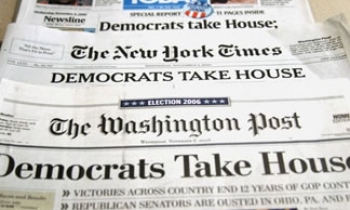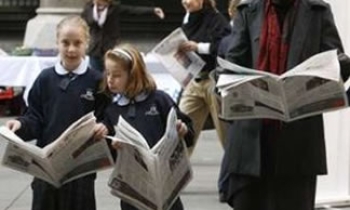Looking for ways to shore up their readership and broaden appeal to advertisers, many U.S. newspapers are adopting a new tactic: targeting narrower and younger audiences.
Newspapers are launching youth-oriented publications designed to attract smaller advertisers that can't afford mainstream papers. They're building search engines to compete with Google Inc. and Yahoo Inc. on a local level. And they are offering "self-serve" classified-ad Web sites, where consumers can create their own ads. In many cases, profits are small, but papers are willing to take the hit in order to break into new markets.
"In the past what newspapers did well was reach broad audiences, but that is not where the growth is occurring," says Scott Flanders, chief executive of Freedom Communications Inc., the closely held parent of the Orange County Register in California and other publications. "If we're going to get growth, it will come from capturing new readers, being able to segment them and being able to let advertisers target audiences."
Newspapers remain a profitable business, despite the high fixed costs of printing plants, news-gathering staffs and home-delivery operations. As the primary advertising option in their local markets, most newspapers have enjoyed significant leverage with advertisers. They use that power to raise prices.
In 2005, publicly traded U.S. newspaper publishers reported that newspaper operations produced operating-profit margins of 19.2%, down from 21% in 2004, according to figures compiled by independent newspaper-industry analyst John Morton. He says that figure is still more than double the average operating-profit margin of the Fortune 500 companies.
A convergence of forces is presenting new challenges to the newspaper business. While advertising price increases have allowed newspaper revenues to continue to rise, in recent years competition from the Internet and other media has slowed the rate of revenue growth.
Newspaper profit margins peaked in the late-1980s at about 23%, Mr. Morton says, and have fallen as low as 11% during recessions. "Newspapers, although they still remain the dominant local advertising vehicles, have lost some of their market power."
Some traditional, big-ticket advertisers are changing their habits. Department-store chains, which have long been major advertisers, are consolidating and cutting their newspaper ad spending, according to Borrell Associates Inc., which provides advertising advice to media companies. Local car dealers, another big source of revenue, are switching more of their ad spending to the Web to reach car buyers online.
Newspapers' classified-ad business -- a major source of revenue for many papers for decades -- also faces competitors on the Web. One is Craigslist, an online classified service operating in 190 markets, which allows users to post free ads for jobs, housing, goods and services. Craigslist makes money by charging for employment listings in three of its markets -- New York, San Francisco and Los Angeles. Sites such as Monster.com, where people look for jobs and workers, and eBay.com, where consumers buy and sell items, also compete with newspaper classified ads.
Meanwhile, the proliferation of free news on the Internet, increased television viewing and changing habits of Americans have diminished newspaper circulation. Daily U.S. newspaper circulation fell 2% to 54.6 million in 2004, the most recent year available, from 55.8 million in 2000, according to the Newspaper Association of America. Daily circulation is down 13% from its peak of 62.8 million in 1985, the trade group says.
Last week, Knight Ridder Inc., the nation's second-largest newspaper chain, said it agreed to be sold to McClatchy Co., a newspaper chain one-third its size, in a transaction valued at $6.5 billion. McClatchy Chief Executive Gary Pruitt wrote in a Wall Street Journal opinion-page piece last week that investors' concerns about the industry allowed his company to buy Knight Ridder for "a price that would have seemed an unimaginable bargain only a few years ago."
In this environment, newspapers are trying innovative ways to protect their business. Consider the Bakersfield Californian, an independent, family-owned paper in central California. When executives heard Craigslist was coming to town last year, they decided to launch their own classified Web site -- and make it free.
Radical Idea
This was a radical idea. For the Californian, classified ads comprised 40% of its newspaper revenue. But Richard Beene, the Californian's chief executive, felt the paper had to make the change. "If we do nothing and newspapers do nothing, we're going to die of a thousand little cuts," he says.
Newspapers are hoping that the Internet will help them capture new readers and advertisers at a low cost. Alexia Quadrani, an analyst with Bear Stearns, says that newspapers' online revenues, although small, could be a growth engine for the future. "The Internet is an area where newspapers could protect and gain market share over time, and this ultimately could help the newspaper stocks," she wrote in a report last fall.
To tap this market, chains such as McClatchy and E.W. Scripps Co. are taking a page from Google's playbook. Using technology from a company called Planet Discover, based in Covington, Ky., the chains have been beefing up the local search engines on some of their newspapers' Web sites.
The goal is to sell ads near the search results, as Google and Yahoo do. But instead of competing head-on with the giant search engines, newspapers are offering search engines that focus on local results.
McClatchy is experimenting with offering flat-rate fees starting at $50 a month for advertisers that want their ads to pop up first alongside search results. By contrast, advertisers must bid for spots on Yahoo and Google and agree to pay a certain amount for each user who clicks on their ad.
"We want to help advertisers secure space in the local marketplace for less money," says Christian Hendricks, McClatchy's vice president of interactive media. McClatchy, which has rolled out the search service in nine of its 12 newspaper markets, has set its sights first on local advertisers that spend a lot of money on the yellow pages, and then will move to other categories. "By the end of the year, it will be the fastest-growing segment of our business," he says.
The local search engines are designed to give readers more than just links to newspaper articles. "It used to be that you would search for 'pizza' on a newspaper site and the first thing you got was a story about a pizza guy who was killed during a delivery," says Bob Benz, general manager of interactive media for Scripps Newspapers. Now, a search for "pizza" on the Scripps-owned Rocky Mountain News Web site, for instance, brings up news articles mentioning pizza -- as well as listings for Denver-area pizza parlors, classified ads selling pizza ovens and jobs at local pizza joints.
Newspapers are also trying to attract new readers and niche advertisers the old-fashioned way -- with print publications. Companies with fewer than 100 employees spend only about 15% of their ad budgets on traditional newspapers, compared with 39% on yellow-pages ads, according to the Kelsey Group, a market-research firm.
"Newspapers are leaving so much money on the table in local markets," says Michael P. Smith, executive director of the Media Management Center at Northwestern University.
Last year, the Orange County Register began delivering a free glossy magazine called SqueezeOC to the homes of 60,000 people it has identified as the "young wealthy" -- those ages 25 to 44, with incomes of at least $150,000, who don't subscribe to the paper. The magazine has attracted advertisers such as bars and restaurants that don't typically advertise in newspapers, the company says. A full-page color ad in SqueezeOC costs about $4,000, while a full-page color ad in the daily paper costs about $17,000.
In 2002, Tribune Co., publisher of the Chicago Tribune and New York Newsday, launched RedEye, a Chicago tabloid aimed at those ages 18 to 34. A year later, Tribune backed a similar paper called amNewYork. These free papers run short news articles, with an emphasis on features and local entertainment listings.
Chicago resident Alison Coppelman, 29, says she picks up RedEye nearly every morning when she buys coffee. "It's an easier read" than mainstream daily newspapers, she says. "It's much more visual. The front page is a gigantic picture instead of being hit with a bunch of text immediately."
Tribune says the two tabloids, which it expects to break even this year, have attracted more than 1,500 advertisers that hadn't advertised in its larger dailies. Ads in RedEye, which has a daily circulation of 100,000, cost about one-sixth the price of ads in the Tribune -- reflecting the fact that the Tribune's circulation is about six times the size of the tabloid's.
Cosi Inc., a Deerfield, Ill., sandwich chain, says it spends its national advertising budget mostly in commuter tabloids. "Big papers are just financially not doable for us," says Jill Lawrence, Cosi's senior marketing director. "The smaller commuter-type papers are cost-effective and we get more bang for our buck." She says Cosi spends about $3,000 for a two-week campaign of ads in RedEye.
To boost its presence in local markets, Gannett Co., the nation's largest newspaper publisher, is increasing its number of specialty publications. These are usually free weekly papers, targeted at niche readers, in areas near its large daily papers. Gannett has nearly 1,000 such publications, up from just above 200 in 2000. In Arizona, for instance, Gannett says roughly half of the adults in Phoenix read its Arizona Republic daily paper at least once a week. But including people who read its Web site, Spanish-language newspapers or its free coupon-filled "shoppers," Gannett says it reaches 76% of Phoenix adults weekly.
Sue Clark-Johnson, president of Gannett's Newspaper Division, said in December at an analyst conference that revenues from the company's "nondaily" publications would be up nearly 13% in 2005 and were expected to rise again "in the teens" in 2006. (Gannett doesn't break out profitability of this segment.) "This opens up good opportunity for new revenues from new businesses; it reduces reliance on major national accounts," she said.
Another Big Change
In another big change, newspapers are experimenting with free classified ads for individuals. Classified ads have long been a major source of revenue for many papers.
In May, Knight Ridder began offering free classifieds online to individuals at all of its newspapers, including the Miami Herald and the San Jose Mercury News in California. The idea is to attract a bigger audience to the classifieds, and then try to sell other services such as upgraded placement of ads.
"This is not about making money. This is about growing readership," says Scott Whitley, advertising director of Copley Press Inc.'s San Diego Union-Tribune, which since August has offered three lines of classifieds free both in the newspaper and on its Web site. He says the paper hopes that as young people find their ads are successful, they will start reading newspapers more regularly.
At the Bakersfield Californian, the paper found that its free classifieds Web site, launched last year, turned out to have an unexpected benefit. As local musicians began using the free site to find band members and equipment, or to advertise gigs, the site attracted a younger crowd that hadn't advertised in the newspaper before and didn't appear to be cannibalizing the newspaper's paid classifieds, the company says. The Californian doesn't make money on the Web site now, but plans to start running paid ads from businesses on the site later this year.
The Californian says its site, called "Bakotopia," attracts between 4,000 and 5,000 visitors a day -- compared with the paper's daily circulation of 65,000. It plans to launch another free classifieds site, aimed at a broader market.
"We decided if we're going to grow, we have to go with the audience, so if the audience goes to digital or niche publications we have to go there," says Mr. Beene, the paper's CEO. "Our margins are going to be slim and we're going to be losing money on some of these."
Trying to lure smaller advertisers, the Californian launched two niche newspapers last year: a free paper targeted at suburbs called Northwest Voice and a weekly newspaper called Mas, aimed at English-speaking Hispanics with higher incomes.
Northwest Voice has already turned a profit -- largely because it consists mainly of reader-contributed columns and photographs. It is picking up advertisers that can't afford the Californian's rates, companies "low to the ground," says the Californian's vice president of sales and marketing, John Wells.
Joe Rueda, the owner of Elliott's Smog and Repair, an auto shop, says he advertises in Mas because he can't afford the yellow pages or the Californian. He pays $280 a month for two 1/8-page ads per month in Mas. The same-size ad in the Bakersfield Californian, twice a month, would cost $775.
Aside from the lower cost, the imprimatur of the Californian gave him confidence in Mas, he says. "Maybe it being part of the Bakersfield Californian, it's got a chance to survive," he says.
Next month, the paper plans to launch another community paper aimed at southwest suburbs. Executives hope "noncore" products, such as the Hispanic and free publications will contribute 20% to 25% of the company's revenues in five years, up from a projected 8.1% in 2006.
Pressure on the Californian to generate new sources of revenue is growing. Earlier this year, one of Bakersfield's largest department stores -- the Robinsons-May store -- closed its doors, after its parent, May Department Stores Co., was acquired by Federated Department Stores Inc. In the year before its closure, Robinsons-May bought a full-page ad every week, bringing more than $500,000 in revenue. Mergers in other industries cost the paper four other advertisers last year, Mr. Wells says.
Meanwhile, the paper continues to defend its traditional turf against local competitors, such as country-music legend Buck Owens, a Bakersfield native who co-hosted CBS's "Hee Haw" in the 1970s. Mr. Owens operates a free publication called Camera Ads that gets much of the ad dollars of Bakersfield's used-car dealers. The Californian attempted to replicate it a few years ago, but its product didn't catch on.
"We don't have a product for the dirt-lot dealers," Mr. Wells says. "They can't afford the Bakersfield Californian. That's our challenge right now."
Mr. Owens, who also owns a radio station and plays guitar weekly at his restaurant in Bakersfield, says he's not worried about competition from the Californian. "We're not trying to do anything but have a classy magazine," he says.
Mr. Beene says newspapers have to accept lower profit margins or else they will end up like struggling U.S. car makers "They keep building high-margin vehicles like big trucks, but their overall market share is dwindling. That's a losing game," he says. "I want to be Toyota."
---- Sarah Ellison contributed to this article.
Write to Julia Angwin at julia.angwin@wsj.com and Joe Hagan at joe.hagan@wsj.com









